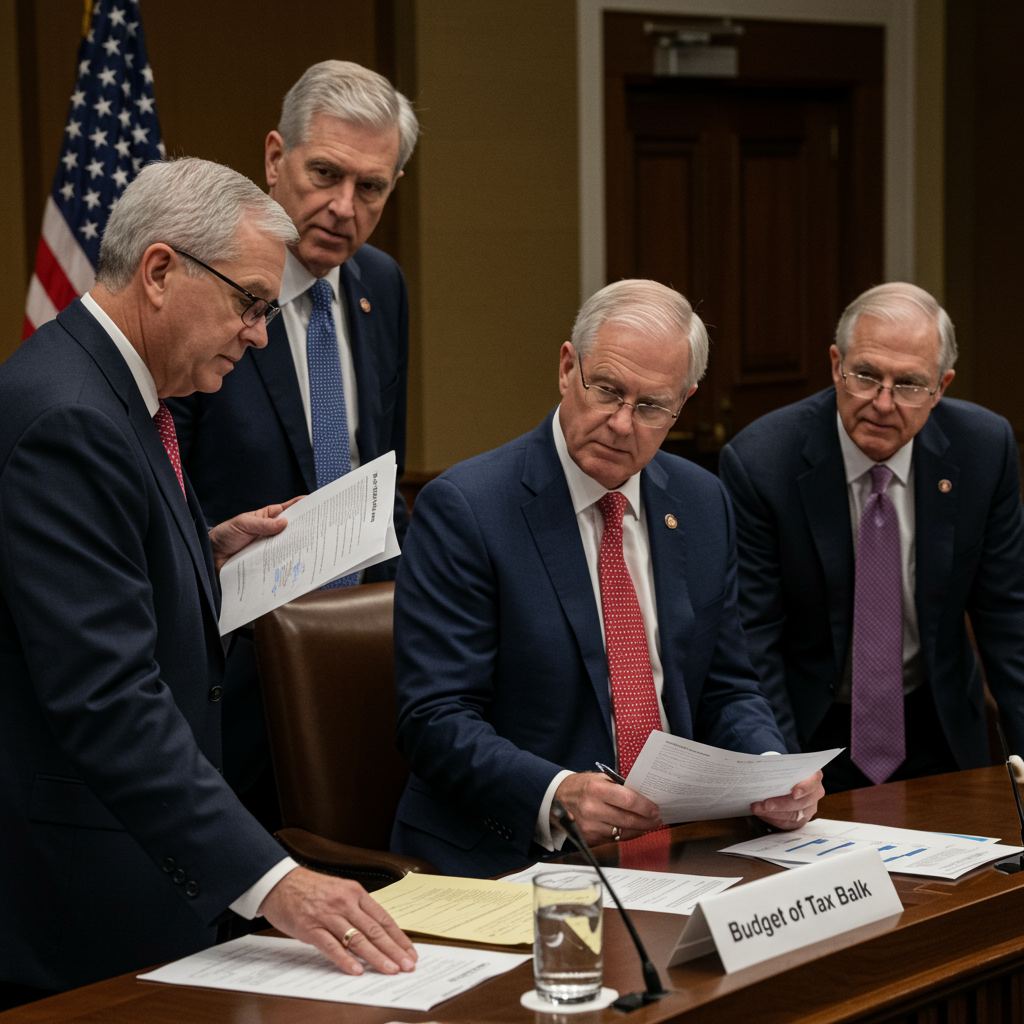Top Republicans in the U.S. <a href="https://news.quantosei.com/2025/06/28/white-house-aims-to-halt-nasa-missions-across-the-solar-system/" title="US Space Leadership Under Threat: NASA budget Cuts”>senate are grappling with a significant financial challenge surrounding a sprawling tax-cut and spending proposal. The bill, a key legislative priority for President Donald Trump’s potential second term, has hit a major snag: a substantial gap in its projected budget savings. This fiscal hurdle threatens to push back a planned vote and potentially derail the administration’s ambitious target of signing the legislation into law by the Independence Day holiday on July 4th.
The primary cause of the budget shortfall stems from rulings by the nonpartisan Senate parliamentarian. This official, tasked with interpreting the chamber’s intricate rules, rejected crucial elements of the bill totaling approximately $600 billion in proposed spending cuts. These cuts were intended to partially offset the massive tax breaks included in the package.
Parliamentarian Rulings Create Fiscal Crisis
The parliamentarian’s decisions necessitate a significant rewrite of large portions of the legislation. The rejected measures include some of the bill’s most contentious provisions. Among these are proposed crackdowns on Medicaid “provider taxes.” Concerns exist among some Senate Republicans that these particular changes could jeopardize the financial stability of rural hospitals.
Beyond healthcare, the invalidated spending reductions targeted student aid programs and aimed to limit federal assistance to so-called “sanctuary” cities. These cities do not fully cooperate with federal immigration enforcement efforts. Combined, these specific areas represent nearly half of the $1.3 trillion in cuts Republicans initially identified to help finance the bill’s estimated $3.7 trillion in tax reductions.
Key Rejected Provisions and Their Impact
Senate Parliamentarian Elizabeth MacDonough ruled against these provisions because they failed to comply with specific budget rules the Republicans are using. These rules, part of a process known as reconciliation, allow certain fiscal legislation to pass the Senate with a simple majority (51 votes) instead of the standard 60 votes typically required to overcome procedural hurdles like a filibuster. For a provision to qualify under these rules, it must have a direct and substantial impact on the federal budget and not be merely incidental policy changes.
According to Democratic Senator Ron Wyden, the parliamentarian rejected healthcare cuts valued at around $250 billion and student aid cuts exceeding $300 billion. Dozens of other proposed elements, including looser regulations for firearms silencers and forcing the sale of public lands, were also ruled out. While these latter items might lack significant budgetary impact, they still failed the test of being primarily budget-related under the reconciliation rules.
Uncertain Timeline and July 4th Target
Despite facing these significant drafting challenges, Senate Republicans had discussed aiming for a first procedural vote as early as Saturday around noon ET. However, Majority Leader John Thune of South Dakota cautioned that this schedule remained an “aspirational” target. Negotiations continue behind the scenes to rework the problematic sections and gain the parliamentarian’s approval.
“We are continuing to explore options on all the outstanding issues and getting readouts and feedback from the parliamentarian,” Thune told reporters, highlighting the ongoing nature of the process.
President Trump acknowledged the possibility that Congress might miss his desired July 4th deadline for passing the bill. Speaking at the White House, he stated, “It’s important, it’s not the end-all. We’d like to get it done by that time, if possible.” House Speaker Mike Johnson echoed this sentiment, admitting the deadline slipping is “possible,” but stressed his reluctance to accept that outcome currently.
Broader Budget Context and Sticking Points
While the immediate focus is on the bill’s budget hole, lawmakers face a more critical fiscal deadline later in the summer. That’s when they must address the national debt ceiling. Failure to raise this self-imposed limit on government borrowing could risk a potentially devastating default on the nation’s $36.2 trillion debt.
Republicans do have some built-in flexibility within their budget framework. They are permitted to increase budget deficits by a total of $3.3 trillion over the next decade. The version of the bill previously passed by the House in May was projected by nonpartisan experts to add $2.4 trillion to the national debt over ten years. These experts warn that such increases worsen the nation’s long-term fiscal health.
Beyond the rejected spending cuts, other sticking points in negotiations include policies related to green energy incentives and the state and local tax (SALT) deduction cap. Reports indicate progress on the SALT issue, with discussions centered on imposing a $40,000 cap for five years, a shorter duration than the 10-year cap in the House version. Negotiations also involved discussions around establishing a fund to help rural hospitals mitigate the impact of potential Medicaid changes, expected to be larger than initially proposed.
Another challenge arose when Republicans dropped a planned “retaliatory tax” on foreign investments. This provision was expected to generate over $100 billion, further complicating the effort to balance the bill’s costs with its savings.
The Path Forward: Votes and Reconciliation
For the bill, informally dubbed the “One Big Beautiful Bill Act” by President Trump, to become law, it must first pass the Senate, then be reconciled with any differences in the House-passed version, and finally signed by the President.
The package aims to extend the 2017 tax cuts, enhance funding for border security and immigration enforcement (including mass deportation plans), eliminate green-energy incentives passed under the previous administration, and tighten eligibility rules for health and food safety net programs like SNAP (Supplemental Nutrition Assistance Program).
With Democrats united in opposition, Senate Republicans can afford to lose no more than three votes from their caucus to pass the bill using the reconciliation process. Similarly, they have limited room for defections in the House.
Signs of Progress and Presidential Pressure
Despite the hurdles, some aspects of the rewrite process have seen success. The parliamentarian reportedly approved a revised provision concerning the SNAP food aid program. This change would shift more costs onto states found to be administering the program inefficiently, according to Republican Senator John Boozman.
President Trump has remained actively involved in the process. His decision to stay in Washington over the weekend, rather than traveling to one of his resorts, was seen as a strategic move to enable him to apply pressure and influence ongoing negotiations.
Republican leaders have expressed optimism despite the delays. House Speaker Mike Johnson indicated they are “very close to a final product.” Senator Lindsey Graham, a close Trump ally, went further, stating he was “never been more confident of the bill passing than right now” and believed it would reach Trump’s desk before July 4th.
Conversely, Democrats, led by Senate Minority Leader Chuck Schumer, have strongly criticized the bill and the Republican push for quick passage. Citing polling data, Schumer argued the bill is unpopular, claiming it would harm Americans by “stealing their Medicaid,” “jacking up their premiums,” and “taking away their jobs,” while disproportionately benefiting “billionaires and special interests.”
The coming days will be critical as Republicans work against the clock, and budget constraints, to finalize the bill and attempt to bring it to a vote.
Frequently Asked Questions
Why were key spending cuts rejected in the US Senate GOP Bill?
Many proposed spending cuts were rejected because they failed to comply with strict budget rules governing the legislative process being used. Republicans are employing a process called reconciliation, which allows bills impacting the budget to pass the Senate with a simple majority (51 votes) instead of needing 60 votes. Under these rules, provisions must primarily and directly affect federal spending or revenue. The Senate Parliamentarian determined that numerous proposed cuts, including those to healthcare, student aid, and “sanctuary” city funding, did not meet this requirement, ruling them extraneous to the bill’s core fiscal purpose.
What is the role of the Senate Parliamentarian in this legislative process?
The Senate Parliamentarian is a nonpartisan expert who interprets the complex rules and procedures of the U.S. Senate. In the context of a reconciliation bill like this one, the parliamentarian determines which provisions comply with the specific budget rules required to bypass the standard 60-vote threshold needed to overcome a filibuster. If the parliamentarian rules that a provision does not comply, it is struck from the bill unless proponents can find a way to revise it to meet the rules or convince the Senate to overrule the parliamentarian (a rare action requiring 60 votes).
What are the next steps for the Trump tax and spending bill?
Before it can become law, the bill must clear several hurdles. Senate Republicans need to finalize the bill text, incorporating changes required by the parliamentarian’s rulings and resolving remaining disagreements (like the SALT cap and Medicaid mitigation fund). They must then pass the bill in the Senate, likely using the reconciliation process which requires a simple majority but limits allowable content. If it passes the Senate, the bill must then be reconciled with the version previously passed by the House of Representatives. Finally, the unified bill must pass both chambers again before it can be sent to President Trump to be signed into law.
Word Count Check: 1143



